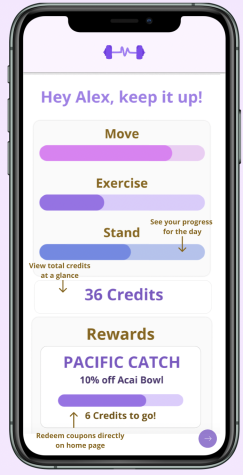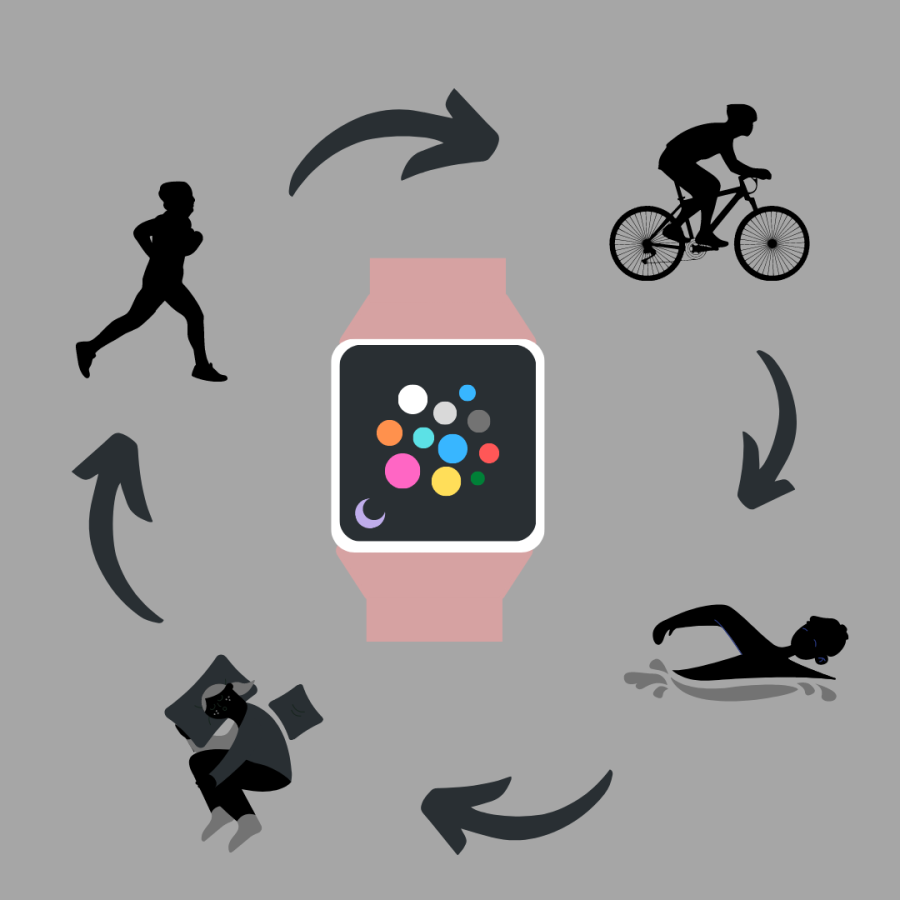Using smart devices to stay fit
Exploring different forms of technology athletes use to monitor exercise progress
The Apple Watch offers a variety of features that track activity Graphic | Irene Tang
March 24, 2022
Junior Urmi Sumant tracks her fitness through her Fitbit, which monitors Sumant’s step count, provides her with stress-reducing breathing exercises and monitors her heart rate while she sleeps. Sumant says that especially during quarantine, these features motivated her to maintain a healthier lifestyle, through activities such as taking a walk through the neighborhood to meet her daily 10,000 step goal.
“Because of my Fitbit, I feel like I’m in better shape than I was before,” Sumant said. “Especially during the pandemic, it was really hard to work out and stay in shape. The tracking has also helped me stay more motivated because I can see my stats and I can see myself improving or not doing so great, depending on what it is.”
Similarly, librarian Laura Utile previously used a Fitbit to help her stay in shape. However, after several years, she transitioned to using an Apple Watch in November of 2021 after hearing from a few of her colleagues about features such as its sleep tracker and messaging. However, Utile’s main use for her watch is closing the Move, Exercise and Stand rings on the Activity app, which ensures that she gets a certain amount of exercise every day.
“I have to work harder to meet my goals on the Apple Watch than I did on the Fitbit,” Utile said. “It’s not as easy to trick it, and so I’m definitely more active with the Apple Watch. On average, every day I’m walking five miles, which I was not doing previously. I was doing 10,000 steps, but it would never always equate to five miles because my Fitbit didn’t have the GPS. With my Apple watch, it’s tracking the actual miles that I’m taking so it’s much more accurate.”
According to Utile, the Apple Watch’s ability to encourage exercise extends beyond just its user. Although her father doesn’t own an Apple Watch himself, Utile’s use of the watch also causes him to exercise.
“My dad’s not good with technology, but I’ll go over and visit him and say, ‘Hey, let’s go for a walk around the block, you have to help me with my fitness scores,’” Utile said. “I can usually talk him into going for a walk with me and getting the exercise that he needs.”

The only downside Utile has found to the Apple Watch is its short battery life. While she was able to use her Fitbit for two or three days before needing to charge it, the Apple Watch’s battery only lasts for one day, and she sometimes struggles to remember to charge it before going to bed.
For Sumant, one drawback of using the Fitbit was the lack of extrinsic motivation. While the desire to stay healthy motivated her, Sumant sometimes found that maintaining her exercise streak was simply not enough to make her go outside.
“One drawback to using my Fitbit is that [while] it provides a lot of motivation in terms of the numbers and statistics that it shows me, such as how much I’ve logged or how many calories I’ve burned, that requires a lot of intrinsic motivation because you have to be able to be self motivated by the numbers that you’re seeing, there’s nothing that you’re actually getting out of doing that exercise,” Sumant said. “It’s sometimes just not enough to take time off my very busy schedules to go and do some exercise.”
Sumant noticed that she wasn’t the only one having this problem, which is why she and her friends decided to code an app called “Earn It” that will partner with local businesses and offer rewards for completing exercises. While the app is still in the process of launching, Sumant has hope in the potential for the app and believes it will encourage many students to exercise more regularly.
“Say they do 10,000 steps in a row for a week, then they could possibly earn like a 10% off coupon from a local boba store,” Sumant said. “This kind of extrinsic motivation for doing exercise would really benefit our students as not only are they being healthier, but they’re also getting extra benefits like boba and other discounts. We already have established partnerships with quite a few local businesses in the area, including Tea Era, Capezio, Eureka and Trailhead Cyclery”
Junior Joshitha Suresh also uses technology to help meet her fitness goals. After encouragement from her cross country friends, Suresh downloaded the application Strava, which she describes as “Instagram for runners.” She found herself using the app daily, mapping out her biking routes and sharing her new best mile time. For Suresh, the app is a way to record and share her achievements with her friends, whether it be a casual run in the neighborhood or a bike ride with friends. The app utilizes GPS location services to track the distance traveled as well as a timer that records her time.
Suresh says that through the Strava app, she discovered that her times were much faster than she had originally thought. She also enjoys its function as a social media app, as it allows her to share pictures and look at pictures her friends share.
“I would be bringing my phone a lot more to track,” Suresh said. “[This way I] get an idea of how I’m doing in terms of running and pacing myself. I’m checking [Strava] a lot more often. [When] I’m [not running] distance myself, I might as well see how my friends are pacing.”



















